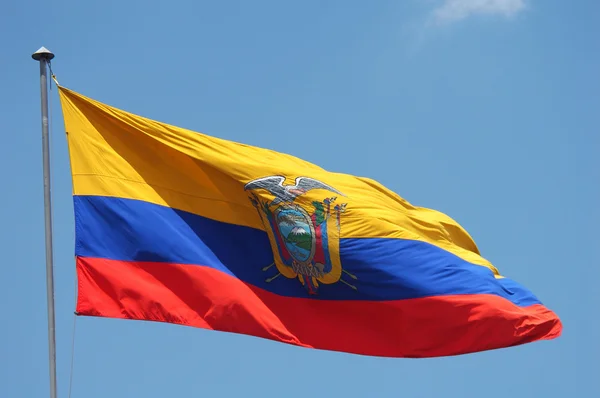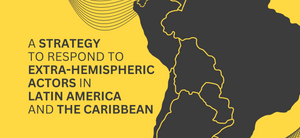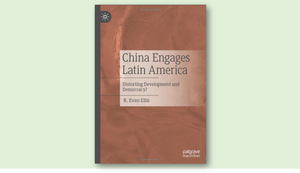
Ecuador’s Security Challenges and the Government’s Response
Introduction
In January 2024, following a series of dramatic public security incidents, including the escape from prison of Adolfo Macias (“Fito”), the leader of the violent Ecuadoran gang Los Choneros, and the takeover of an Ecuadoran Television station during a live broadcast, the newly elected government of Daniel Noboa declared a “state of internal warfare” in the country. Through Presidential Decree 111, he designated 22 violent criminal entities operating in the country as “terrorist organizations” and authorized the employment of the Armed Forces in a broad range of security operations from supporting the control of the nation’s interior and borders, to deployment in prisons, to operations against illegal mining.
Ecuador’s escalating security challenge has been years in the making. Contributing factors include the takeoff of cocaine production and the fragmentation and empowerment of criminal groups in neighboring Colombia since its flawed 2016 Peace Accords there, the geographic position of Ecuador as an outlet and logistics hub for cocaine produced in both of its neighbors Peru and Colombia, the development of ties between Ecuadoran criminal gangs and outside criminal actors including the Sinaloa and Jalisco Nueva Generacion cartels of Mexico, the National Liberation Army (ELN) and dissidents elements of the FARC in Colombia, the Albanian mafia, and Ndrangheta and Camorra mafias of Italy, among others.
The Noboa government and its security forces have taken important steps to address the nation’s security crisis, yet face multiple significant reinforcing challenges that raise significant doubt about its ability to make headway, including the massive scale of the illicit drug and mining flows through the country, both the power and fragmentation of the criminal groups operating in the country, the depth of corruption of Ecuadoran institutions combatting the threat, and grave concerns regarding the inadequacy of resources, coordination, and concepts of employment.
Compounding the stakes for Ecuador, in February 2025, Ecuadorans go to the polls in the first round of elections to choose a new President, National Assembly, and other members of government. The government’s performance in the fight against crime, corruption and insecurity will be a dominant factor in who Ecuadorans chose to lead them. Their dissatisfaction with the performance of the Noboa government, however, favors his principal rival, Luisa Gonzalez, whose victory could bring the return of the party’s anti-U.S. leftist Godfather Rafael Correa, and associated policies decreasing Ecuador’s security cooperation with the U.S. and Western institutions, accelerating the country’s devolution into a narco state, as happened in nearby Venezuela.
The present work is based on extensive conversations by the author with Ecuadoran security experts during a December 2024 research trip to the country, focusing on the challenges facing the country and the government response.
Challenges
The principal driver of Ecuador’s current security challenge is the flood of cocaine through the country heading for markets in Europe, the U.S. and elsewhere. As noted previously, those cocaine flows were greatly expanded during the previous decade by the flawed 2016 peace accords in Colombia which fragmented and shook up the environment of criminal and terrorist groups operating there, and facilitated an explosion of cocaine production in the country, looking for export markets. That expanded cocaine production in Colombia accelerated further with the policies of its current leftist President Gustavo Petro to cease eradication efforts against coca growing in the Colombian countryside, and seek to make peace with the country’s criminal groups. Together, those policies lead to a 53% explosion of cocaine production in a single year in Colombia. At the same time, cocaine production was also expanding in Ecuador’s neighbor to the south, Peru, including near its border with Ecuador. In both cases, that expanded production was channeled through criminal groups already looking to Ecuador as a center for storing and exporting the cocaine to external market.
Cocaine has historically been smuggled into Ecuador through foot traffic, warehoused in the country before being smuggled out through its Pacific-coast ports. In some cases, however, the cocaine is moved via aircraft, landing on clandestine airstrips, particularly in the provinces of Esmeraldas and Manabi.
As cocaine production in Ecuador’s neighbors expanded, the Mexico-based cartels Sinaloa and Jalisco Nueva Generacion (CJNG) began working with local gangs and Colombia-based groups to smuggle the cocaine into Ecuador, store it there, and export it through the country’s coastal ports such as Guayaquil, Manta, and Esmeraldas. The December 2020 murder of Rasquina, boss of Ecuador’s principal gang Choneros, which was working with the Sinaloa cartel, set the stage for the fragmentation of the gang structure, with the empowerment of new groups such as the Chone Killers, Tiguerones, Lobos, and Lagartos, backed by CJNG, substantially increasing the violence in the country as the groups competed for drug routes. Groups such as the Albanian mafia, and Italy’s Ndrangheta, focused on exporting the drugs to Europe, also contributed to the criminal dynamic, although according to those interviewed for this work, they generally stay clear of becoming directly involved in sourcing the drugs in Ecuador and competing for routes.
Interacting with the drug flows, an illegal mining economy emerged in Ecuador, throughout the country. In the north, such mining is concentrated in Ibarra, and in Imbabura in the vicinity of the town of Buenos Aires. In the south, it occurs principally in Zamora-Chinchipe and Loja, and in the Podocarpus national park which spans the provinces. In Ecuador’s jungle region gold is principally leached from rivers, concentrated in the Pastaza, Napo, and Esmeraldas areas, but also includes open pit mining in the coastal department of Los Rios.
In Ecuador, as in Peru and other parts of the region, Illegal mining also reinforces illicit drug activities, including serving as a vehicle for laundering narco money.
In Ecuador, cocaine and the illegal mining economy, including extortion of legally-operating mines, have also become a focus of Colombia-based terrorist and criminal groups operating in the country.
Regarding Colombia’s National Liberation Army (ELN), Ecuadoran officials report that the Northeastern warfront has presence in the north of Ecuador in the frontier with Columbia, in the provinces of Babura, Carchi, Esmeraldas, and Sucumbíos. The ELN Eastern Front reportedly has a presence in Sucumbíos, Orellana, and Pastaza. The ELN Commander Ramiro Vargas warfront reportedly has a presence in Esmeraldas.[1]
Of the dissident groups of the Revolutionary Armed Forces of Colombia,” the 48th Front has a presence in Sucumbíos, bordering Colombia. The 29th front is in Carchi and Esmeraldas. The Oliver Sinisterra front, considered the most dangerous of the FARC organizations in Ecuador, has a presence in Esmeraldas. The Commander Alfonso Cano Front is in Sucumbíos and Orellana, where it reportedly cooperates with representatives of the Mexican Cartel Jalisco Nuevo Generacion (CJNG). Other FARC dissidents are reportedly operating in the provinces of Morona, Santiago, and Pastaza as well. [2]
The previously mentioned Albanian mafia has operated in Ecuador, in a rather low-key fashion, since approximately 1990. In addition to sourcing drugs in the country, they are reportedly involved in money laundering in the country, extortion, kidnapping, and trafficking in persons. In addition, the Italian mafia, including Ndrangheta and La Camorra, have been in the country since approximately 1970, also involved in drug trafficking, money laundering, extortion and kidnapping, and trafficking in persons, with a specialty in prostitution of women and children. [3]
Beyond these groups, the significant influx of Venezuelans into Ecuador. The United Nations estimated that 475,000 Venezuelans were in Ecuador as of 2023, 55% of the total migrant population of the country. The desperate situation of many displaced Venezuelans has also created opportunities for the Venezuelan gang Tren de Aragua to establish itself in Ecuador since approximately 2020, focusing on human smuggling and trafficking of Venezuelans.
Fuel theft and smuggling is also a significant problem in Ecuador, due in part to gasoline subsidies which make it lucrative to buy or steal it in Ecuador and sell it in neighboring Colombia or Peru. Petroleum products are also robbed from Ecuador’s pipeline system with the collaboration of petroleum industry workers from Petroecuador who tip off the criminals regarding when fuel is being pumped through. More than $215 million in fuel was reportedly stolen from Petroecuador during the previous year. The principal target is reportedly Ecuador’s older SOTE pipeline, which moves a lighter crude referred to as “white gasoline” which can be used in Ecuador and neighboring Colombia, to transform coca into cocaine. Such robberies are reportedly particularly problematic in the section of the pipeline from Santo Domingo to the coast near Guayaquil.
The struggle between armed groups in Ecuador for narco-routes, their fragmentation, and attempts to intimidate the state and local populations has produced an explosion of violence and public insecurity in the country. The country’s homicide rate reached 44.5 murders per 100,000 people in 2023, a 74.5% jump over the previous year, which was itself 500% greater than the rate in 2016 when homicides began taking off. One of the worst examples of the dynamics behind the violence is the Guayaquil suburb of Duran, a key site for warehousing illicit drugs smuggled onto ships exiting the port of Guayaquil, contested between more than 22,000 members of the Latin Kings and the Lagartos and Chone Killers. In 2023, Duran registered a homicide rate of 147 per 100,000, surpassing Colima and Ciudad Obregon in Mexico as the most deadly urban area in Latin America.
Beyond killings, people interviewed for this work also reported increased incidents of extortion of local businesses throughout the country. Although few cases are reported, in 2022, demanded extortion payments, referred to colloquially as “vacunas” (vaccines), was 300% higher than in the prior year.
One grave symptom of the crisis arising from the level of illicit flows through Ecuador’s institutions has been significant corruption. Major scandals, including Metastasis, Plaga and Purga, unfolding at the time of this work, were producing convincing revelations from wiretaps and other sources implicating police and other officials at the highest levels. In November 2024, Police General Pablo Ramirez was sentenced to nine years in prison for corruption from charges coming out of the Metastasis case. The prior head of Ecuador’s national police, Tania Varela, was referred to in one of the investigations as the “Godmother,” while her replacement, Police General Fausto Salinas, was removed from office in October 2023, with $2 million of unexplained income later discovered by authorities in the bank account of his wife and family. [4] In February 2023, Danilo Carrera, brother-in-law of ex-President Guillermo Lasso was revealed to have been investigated by Ecuadoran authorities for ties to the Albanian mafia. In 2024, a total of 430 Ecuadoran police officers were relieved of their duties, generally on suspicions of involvement in corruption.
Ecuador’s penal system has also been significantly challenged by the new level of criminality. The 26 prisons administered by the National Prison Service SNAI have not been able to effectively control their populations, or stop the smuggling in of contraband including cash, cellphones, arms and explosives, including via drones. Indeed, in September 2024, a drone carrying explosives was used to attack Ecuador’s maximum-security prison “La Roca”. Ecuador’s prisons have been the site of repeated massacres among the population, escapes, and the assassination of prison leaders.
Compounding law and order challenges, the country has also experienced significant power outages and wildfires as a result of severe drought, obligating armed forces participation in the response. Some of the wildfires, particularly seven breaking out simultaneously on September 24, 2024 in the metropolitan area around the capital Quito, were believed to have been set deliberately, either by criminals, or actors seeking to politically destabilize the Noboa government. [5]
The Ecuadoran Government Response
In response to the security crisis, in January 2024, the Noboa government declared a state of internal armed conflict in the country and designated 22 groups as terrorist entities, giving the state special legal authorities to combat them. Under Decree 111 declaring the state of internal armed conflict, and also under Decree 110, declaring a nationwide state of exception, the Noboa government gave the military a range of additional responsibilities to support civil authorities in managing the security crisis. This included (1) empowering them to combat terrorist groups, (2) conducting patrols in the country to provide citizen security, (3) establishing a presence in the jails, (4) combatting illegal mining, (5) controlling the clandestine passages on Ecuador’s land border, as well as controlling its maritime spaces.
The overall approach was represented in the government as “Plan Phoenix,” although for some, the closely guarded specifics were considered too ambiguous.[1] The government also imposed a 3% increase in the national value added tax to pay for the program, although some interviewed expressed concern that the additional needed resources generated by the tax increase had not reached their organizations. [6]
Over the course of 2024, the Armed forces executed these missions, as well as its traditional ones such as controlling the country’s maritime borders and protecting critical infrastructure. Positive results included an 18% year—on-year reduction in the homicide rate reported by the government in November 2024.
The military has also taken action against illegal mining. In January 2022, it successfully intervened with 1,500 military and police personnel against the illegal mining activities in Yutsupino, in the province of Napo, seizing some 60 pieces of heavy equipment. It tried to conduct similar interventions in 2023, but reportedly found that the information about its intended targets had been leaked, allowing the miners to withdraw their equipment before the military’s arrival. [7] In some cases as well, illegal mining products confiscated by the Ecuadoran mining authority Arcen, are robbed from state custody through corruption.
To address fuel robberies, the Ecuadoran military actively patrols the nation’s pipelines, including the segment from Lago Agrio to Esmeraldas.[8] Since June 2023, its patrols are supplemented by drones, in a collaboration between Petroecuador and the Corps of Engineers of the Ecuadoran Army, in order to monitor the pipelines for perforations, although sometimes the perforations are done from underground, requiring other detection techniques to be employed. [9]
Since January 2024, the Ecuadoran military has deployed to the nation’s prisons, including into the interior of facilities in Cuenca, Guayaquil (Littoral), Manabi, and Quito, as well as establishing perimeters around the rest of the 26 facilities in the SNAI system. The result has been a decrease in massacres between groups within the nation’s jails, although contraband was reportedly still getting in and violent incidents continued to occur outside the facilities. In addition, when the military withdrew from the interior of those facilities in November, incidents reportedly went up once again, including the massacre of 15 people that month within the maximum security “Littoral” prison in Guayaquil.
In addition to its deployments, the Ecuadoran Armed Forces has also begun to make organizational changes to address the challenge of combatting criminal entities, including the April 2024 announcement of a new joint task force against terrorism, CECOT.
In support of specific deployments, during 2024, the Ecuadoran military incorporated and deployed a number of assets that it had bought and/or received as gifts as the violence had increased during the preceding administration of Guillermo Lasso, enabled by increases in the military and other security budgets under that administration. The new equipment included 20 Cobra-2 4x4 and 15 Otokar URAL 4x4 armored vehicles from Turkey, 237 Shladot David 4x4 armored vehicles and a number of ARAD IWI rifles from Israel. It also included receipt of a C-130H transport aircraft from the United States in March 2024, as well as two 110-foot patrol ships, received from the United States Coast Guard in December 2024. In addition to the material received from the U.S., in April 2024, the South Korean government delivered a KCG 3001 frigate to Ecuador for patrolling its coastal waters, including providing greater coverage out to the Galapagos. The ship, the largest ever donated by South Korea to a foreign partner, was the third ship it has provided to Ecuador since 2020.
To strengthen control of its airspace, Ecuador’s Air Force is working to increase the operational availability of its Tucano interceptor aircraft from three of its 17 Tucanos at present, to seven within a year, and 12 or more by the following year. [10] Although its air radar at Montecristi, sabotaged by criminals in 2022, continues to be down, it is also acquiring a number of new radars to strengthen its air and maritime domain awareness near its coast.
On the other hand, although Ecuador has a law governing aerial interceptions, some interviewed for this work noted that its ability to stop or deter narcoflights limited by the legal restrictions on shooting down an aircraft violating the national airspace.
Beyond interceptors aircraft, to support military mobility and a number of other security tasks, the Ecuadoran Army is acquiring five Super Puma mid-sized helicopters, to be received in the end of 2024 and early 2025. The acquisition of the helicopters, although expensive, will begin to address a shortage that was so grave that Peru’s Air Force provided help through sending its own helicopters and aircraft to help the country combat wildfires in the province of Loja, the south of the country, in September 2024.
Ecuador has previously also considered acquiring attack helicopters, and has indicated an interest in acquiring SH-60 Blackhawk helicopters from the U.S.
In addition to equipment, the Ecuadoran military also continued to receive expanded institutional and training support from the United States. That support was bolstered by the January 2024 visit by head of U.S. Southern Command General Laura Richardson to Ecuador, as well as a September 3, 2024 agreement for the U.S. to provide an additional $25 million in security assistance and support to the Ecuador judicial system In addition to such assistance, during the past two years the Kentucky National Guard, Ecuador’s State Partner in the U.S. State Partnership Program (SPP) since 1996, has expanded its level of support to approximately 20 engagements per year with its Ecuadoran partners.
To support its coordination with the U.S. in activities more broadly, Ecuador maintains four military liaison officers within the U.S. embassy in Quito, a liaison in U.S. Southern Command.
With respect to U.S. support for the education and training of its Armed Forces, the U.S. hosts Ecuadoran military students in the U.S. Western Hemisphere Institute for Hemispheric Security (WHINSEC) in Fort Moore, Georgia and the U.S. Army War College, among other institutions.
Beyond the United States, Ecuador also coordinates closely with its neighbors, particularly Colombia and Peru with which it shares land borders, including regular meetings and information exchanges through binational frontier committees (COMBIFRONs). Ecuadoran and Colombian forces conduct coordinated “mirror” operations, as well as holding monthly joint planning meetings, alternating between Ipiales on the Ecuadoran side of the border, and Turkan on the Colombian side. [11] On the southern border with Peru, Ecuador conducts similar activities, although restrictions on the ability of the Peruvian military to deploy in its border region restricts the frequency of operations that Ecuador can jointly conduct with its Peruvian counterparts there. [12]
The Ecuadoran Armed Forces land, maritime and air domain awareness is further supported by engagement with both the U.S. and their neighbors. Ecuador’s air and maritime domain awareness are both supported feeds from the U.S. Joint Interagency Task Force South (JIATF-S), where Ecuador has an embedded representative. In addition, Since 2021, the United States also flies two P-3 surveillance aircraft in support of Ecuador’s maritime domain awareness.
With respect to combatting money laundered through Ecuador’s institutions, the country has a relatively credible financial intelligence organization, the Financial and Economic Analysis Unit (UAFE). Experts consulted for this work, however, expressed concern whether it had the resources and capabilities to respond to all of the cases reported to it. [13]
Challenges in Ecuador’s Response
Despite these advances, experts consulted by the author expressed concern over a range of impediments to the success of the military, in support of police and other civil authorities, in the conduct of their mission.
In general, significant corruption, including within the national police, prosecutorial and judicial system, and at the highest levels of Ecuador’s political system, inhibits their effectiveness, whatever level of resources and coordination are applied. Ecuadoran officials consulted for this work expressed frustration with spending considerable resources and putting the lives of team members at risk to conduct operations, only to have prosecutors not charge those detained, or judges, presumed to be corrupted, letting those detained go free. [14]
Such corruption was also perceived to have contributed to compartmentalization of information among military, police and national intelligence officials, who are often reluctant to share information with counterparts in other government organizations they fear have been compromised by criminals.
Such corruption and distrust, in addition to the prioritization of political loyalty over organizational experience in the appointment of senior officials, was seen with concern by some interviewed as playing a role in the loss of jointness in the planning and conduct of security operations, as well as other government functions.[15]
Numerous persons interviewed for this work also expressed concern regarding the unsustainability and risks of the mission that the Ecuadoran military was being asked to take on. On one hand, several worried that the deployment of the military inside Ecuador’s prisons, would have a corrupting effect on its personnel, suggesting that there had already been low level cases, such as military members accepting money or other benefits to allow contraband into facilities. [16]
Several of those interviewed expressed concern that the combination of new requirements on the military and the associated required rotation of personnel between assignments was degrading institutional capability in dangerous ways, including added wear on equipment, deferred maintenance, and neglect of training. Some expressed concern that even Air Force security personnel, whose existence, in very small numbers, is required to protect the security of airbases, were being deployed outside those facilities to contribute to the military’s presence in public spaces, at the possible cost of installation security. [17]
Another contributing factor to the workload on the military noted by those interviewed was the doubling of the geographic extent of the border region that the military is administratively responsible for, in both the northern and southern borders of the country, from a 10 kilometer to a 20 kilometer strip, without a corresponding increase in resources to cover that area, even while simultaneously increasing demands on the military to engage in multiple other activities. [18]
Related to the sustainability of the level of tasking being given to the military, some interviewed questioned whether it would not be more appropriate to concentrate military efforts on controlling borders and maritime spaces, to restrict the flows of persons and illicit goods into and out of the country, rather than diverting them away from such tasks by deploying them throughout the country in areas such as prisons, checkpoints, and providing security for key individuals and sites, that they argued did not make optimal use of military capabilities, training, and authorities.
In a similar vein, with regard to the employment of recently acquired David armored military vehicles, one expert interviewed expressed concern that the decision to disperse them in small quantities to different units throughout the country, rather than using them as a concentrated force as they were intended in originally making the acquisition, both undermined their operational effectiveness, and increased the risk they would not be maintained properly in the diversity of units to which they were being deployed.
Beyond such issues of military overtasking, some interviewed for this work worried that the suspension of the ability of uniformed military personnel to leave the service when their enlistment period ends, due to Decree 111, was undermining morale and discipline by creating a small but problematic group of persons who felt trapped in the service against their will and forced to engage in sustained hazardous or unpleasant duties such as deployment to the interior of prisons.[19]
Beyond such potentially adverse institutional effects, some interviewed for this work expressed concern whether the military had adequate training, doctrine and equipment for the types of missions they were being asked to perform. These included a shortage of protective gear and non-lethal arms for missions involving contact with the population, with soldiers sometimes having to share protective gear between shifts. Those interviewed also expressed desire for better intelligence gathering capabilities appropriate to the internal security missions for which they were being assigned, such as listening devices for deployment in prisons. Others expressed concern whether the intelligence on criminal matters available to the military through the national police, civilian intelligence organization or their own military intelligence structures, was adequate to the tasks they were called upon to perform.
Finally, some expressed concern over the inadequacy of the legal framework for the use of the military in missions involving prolonged contact with their own domestic civilian population, even with Decrees 111 and 110. The 2008 Constitution, they noted, had abolished special courts for military and police personnel. While a 2023 enabling act supporting conduct of law enforcement functions by the military made provisions for special chambers in civilian courts for military and police cases, such chambers in practice have generally not been established. Those consulted about the issue did note, however, that the civilian court system does make an effort to accommodate the special concerns regarding military involvement in law enforcement matters, including helping the military to have the knowledge to operate in the civilian court system, and generally not requiring pre-trial detention for accused military members in civilian jails where they might be exposed to the very criminals they have been combatting.
From a doctrinal perspective, several interviewed for this work expressed doubts whether the conditions for declaring a state of internal armed conflict actually existed. Such conditions arguably include the existence of a relatively unified opponent contesting the state for political authority over territory. Similarly, some interviewed questioned “terrorist” designation of the 22 violent criminal groups under Decree 111, and the corresponding rights and obligations that such a designation implied under international law.
Conclusion
In the short term, the magnitude of the security challenges confronting Ecuador may greater than its institutional capacity to handle. Driving these challenges is a factor largely out of control of the Ecuadoran government: the enormously expanded flows of cocaine and other elements of the illicit economy, and its effect on corrupting Ecuadoran institutions and generating unprecedented levels of violence, as increasingly fragmented gangs compete for drug routes, while also engaging in extortion and other crimes to sustain themselves.
Ecuador’s military, national police and other security forces have tackled their country’s security challenges with competence and professionalism, with the active support of the United States and other partners, yet Ecuadorans and others also reasonably worry that that the combination of corruption, limits in government coordination, lack of resources, and possibly mistaken policy choices may make the response insufficient.
As grave as those doubts may be, however, for many Ecuadorans, they are also offset by fears by some that disillusionment with the current path could open the door to a return of the populist governance of Rafael Correa’s Citizen Revolution party, whose renewed isolation of Ecuador from Western security, economic and law enforcement partners, political and military collaboration with non-democratic extra-hemispheric partners such as Russia and China, and a return to corruption at the highest levels of government, tied to projects with the People’s Republic of China, could lead the country to an even worse fate than that it is currently struggling against.
[1] Interviews off-the-record with security expert in Quito, Ecuador, December 2024.
[2] Interviews, 2024.
[3] Interviews, 2024.
[4] Interviews, 2024.
[5] Interviews, 2024.
[6] Interviews, 2024.
[7] Interviews, 2024.
[8] Interviews, 2024.
[9] Interviews, 2024.
[10] Interviews, 2024.
[11] Interviews, 2024.
[12] Interviews, 2024.
[13] Interviews, 2024.
[14] Interviews, 2024.
[15] Interviews, 2024.
[16] Interviews, 2024.
[17] Interviews, 2024.
[18] Interviews, 2024.
[19] Interviews, 2024.



